By Chris Becker
Here’s my roundup of what happened in major macro markets in the last week and what could happen in the weeks ahead as the world’s central bankers continue to apply the “milkie wilkies” of easing, liquidity, and low/zero interest rates.
Remember, the following views are my own, do not constitute advice and are for information purposes only. I may have positions in any or all of the below and their associated markets both long and short, on an intra-day, daily and weekly basis for my own account. Please seek advice from a licensed adviser before making any investment decisions.
Currencies and Gold
The first method of gauging currency strength is through the US Dollar Index (DXY), made up of a basket of major currency pairs against the USD. Since the GFC it has been the major “risk on/risk off” indicator, with a lower USD usually meaning higher risk as US stock markets rise and push other risk assets higher, such as our own share market. But there has been a shift, as witnessed by the decline in the “undollar” currency, gold, which I’ll cover shortly.
On the weekly chart you can see that in comparison with QE2, where the DXY declined some 12%, QE3 – if measured by USD weaknesss – has not been successful at all as the currency wars continue. The DXY is still above resistance at 81.5 points but has been unable to reach the interim pre-QE3 84 point target, although the weekly ADX indicator is starting to move into strong territory:
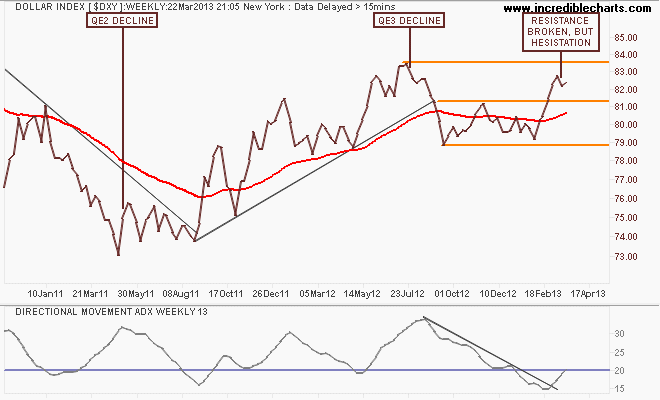
A bearish megaphone pattern is forming on the daily chart, with a bearish divergence on the MACDH lower indicator. What does this mean? Prices are trying to make new highs, but the low days are getting more volatile, widening out the “megaphone” instead of a smoother trend channel.
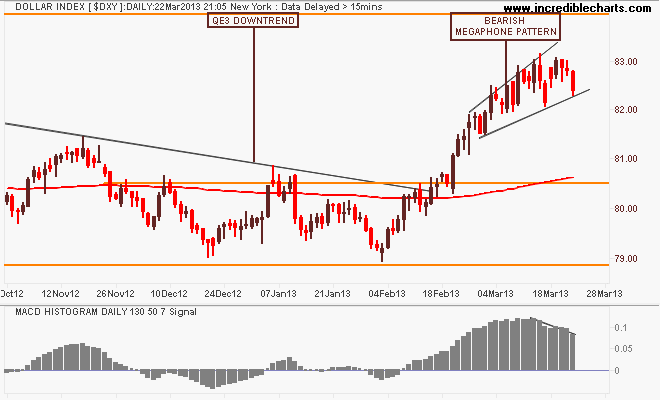
I think we can expect some volatility in the week ahead on the DXY, as markets react to Cypus and other issues.
Because of its composition, the general opposite of the DXY is the euro (EUR/USD). After its break of the year plus down trend in August last year, the euro had broken out above resistance (former support) at the 1.31 level before becoming overbought and correcting. In previous weeks we’ve seen a consolidation below 1.32 and while price falls, there has been considerable intra-week support as the bullish candles show:
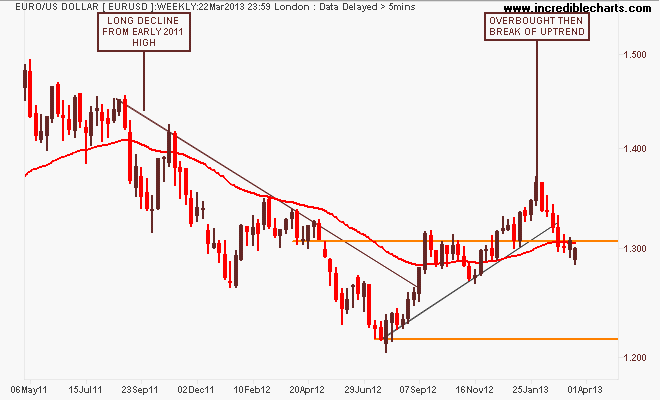
Here’s the shorter term picture with an obvious channel between resistance at 1.32 and support at 1.28. This week has still seen declines, but the move is declerating, with long tails under the daily candles (indicating intraday buying support at lows) and a strong finish to the week. My preferred momentum oscillator shows a reversion to mean in the trend, indicating a possible bullish reversal in the week ahead.
I still contend the medium term path for the euro is down, but we could see a retest of the overbought 1.37 high if the US dollar weakens further in the short term:
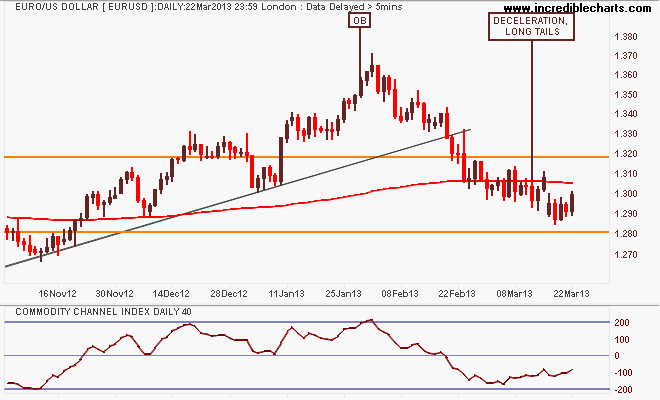
With the RBA continuing its handsoff to approach the Aussie “battler” (AUDUSD) continues to strengthen, but don’t become as confused as the economists calling the AUD path – stand back and look at the longer term chart:
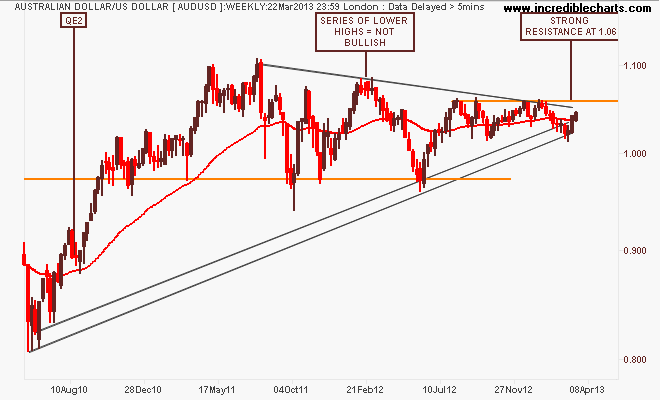
Weekly charts are fine for having both an opinion and a position in currencies – and the AUD is no different. Look at that strong resistance overhead at 1.06 combined with the series of lower highs since mid 2011. Conversely, the buying support at the trendlines (intraweek and close of week) below are equally strong, and you have a potential breakout OR a continues sideways move…now I sound like an economist.
In any rate, buying puts on the AUD as it approaches 1.06 on cyclical strength (and USD weakness) could be a big payoff if other institutions sell the AUD at those overbought levels.
The daily chart below shows how the sideways condition for the last 12 months could continue, evermore:
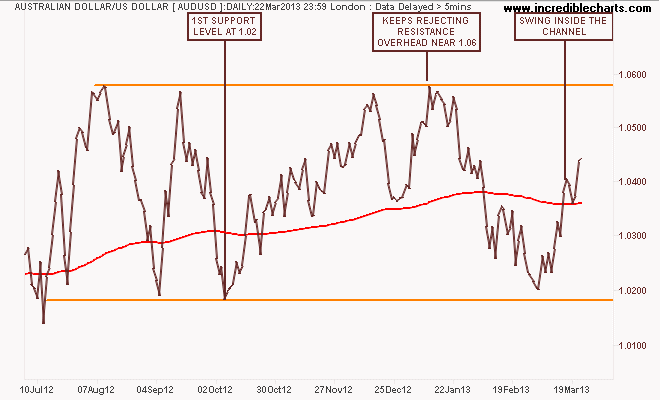
I’ll finish the currency section with the undollar currency, gold (USD) which I’m sure a lot of you are interested in hearing about!
Here’s another weekly chart showing a sideways consolidation, where price has recently bounced off nearly 2 year support level at $1560 per ounce.
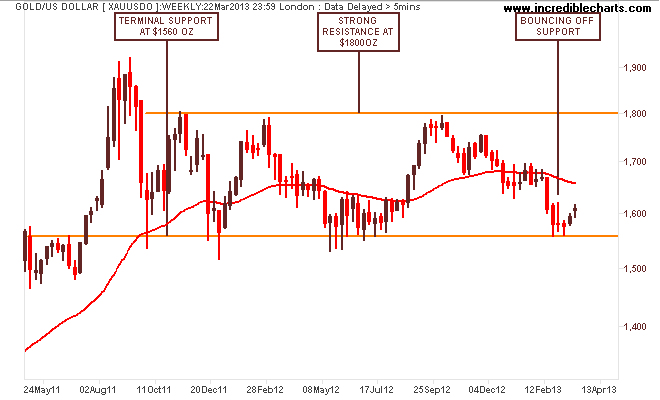
As I said previously, the daily chart paints many different pictures, depending on your point of view. Coming into this week I was bullish short term but only on a swing trade, not a new trend or breakout. My preferred MACDH setting is not yet positive, although the bullish divergence to the zero level is very clear. I’m looking for a break of $1620-30 region for a medium term long position:
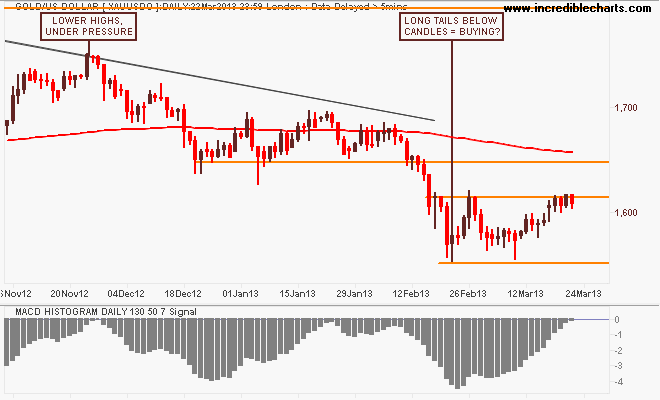
Commodities
For Australian investors particularly, there’s three major commodities to watch: crude oil, copper and iron ore. I’ll leave the last to Houses and Holes with his excellent daily updates (although it’s non tradeable for retail/private investors – Fortescue Metals (FMG) and Atlas Iron (AGO) are excellent proxies, both of which I trade regularly), but crude oil and copper are great barometers displaying both real demand and US dollar strength/weakness.
First, lets take a quick look at the WTI Crude marker, which had another ok week on USD weakness, slowly forming a bullish ascending triangle patter that could break out if the USD breaks down. Here’s the weekly chart for context:
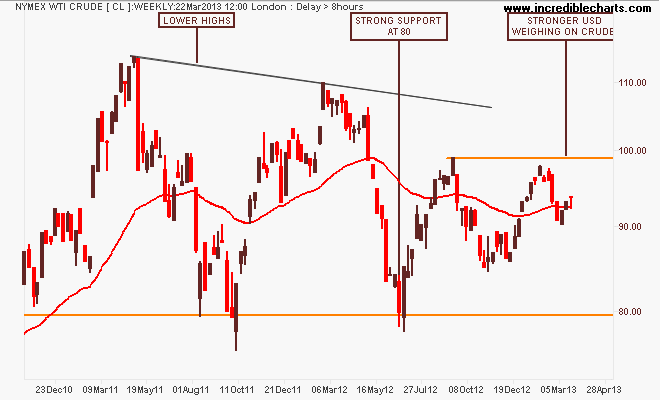
ICE Brent Crude paints a slightly different picture, with the weekly chart of the spot price showing a false breakout above resistance at $117 per barrel that has reversed markedly to almost break support:
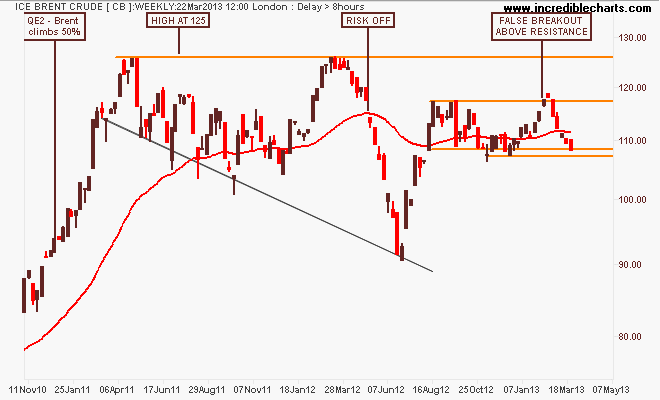
The daily chart shows a slide down in price to strong support at $106 per barrel, with a slightly oversold condition that could revert in the week’s ahead. This is another potential sideways channel commodity (like the AUD) to watch:
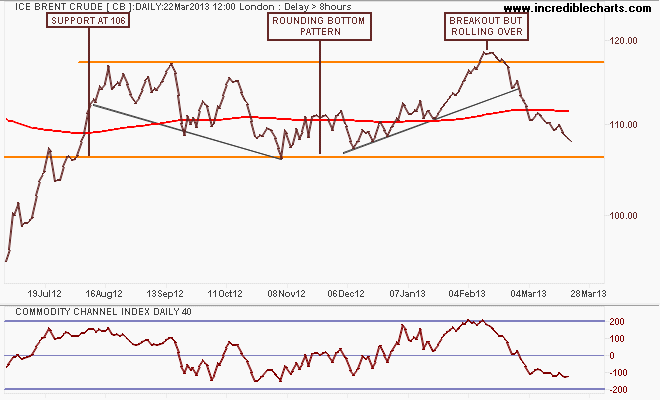
I asked last week if the picture is changing for Copper? The key industrial metal still has that big Monty Python foot called the USD pushing it down as the weekly pattern morphs into a symmetrical triangle, with a definite bearish bias. Industrial demand and production or lack thereof is being reflected in the weakness in copper:
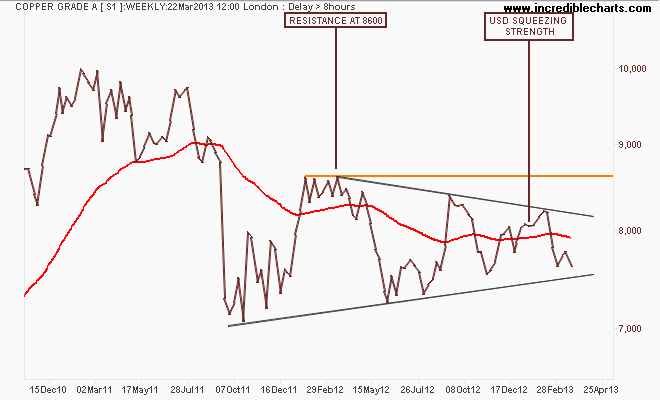
Equity Markets
Now to stocks, actually first the VIX, now below the pre GFC “everything is fine” levels!
There’s no need for a daily chart (which I view each night/morning as part of my routine as it effects my position sizes and contingency plan)-here’s the weekly for context:
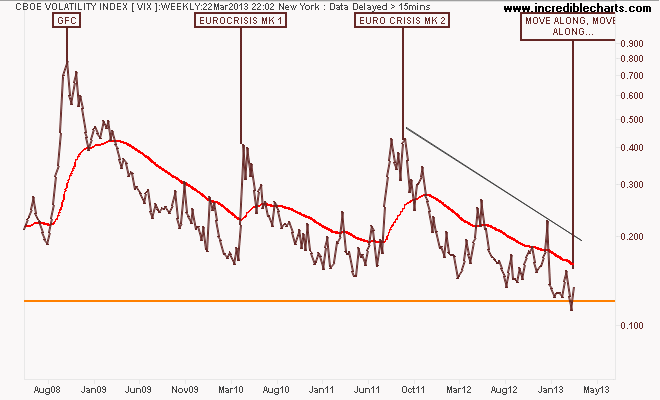
Before I get to the Aussie market, let’s look at the US S&P500 starting with the monthly chart showing a possible end to the US secular bear market, going on 13 years from the tech bubble high in 2000:
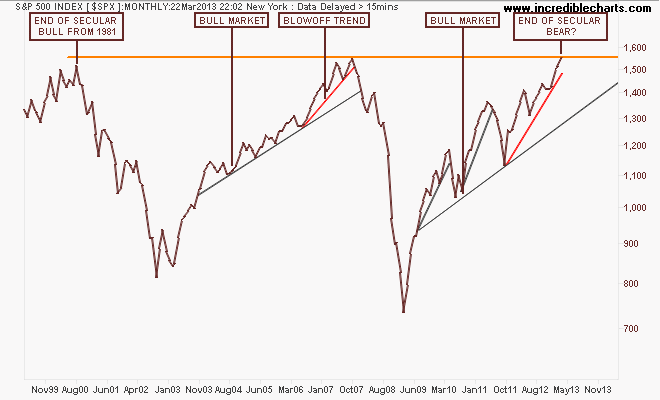
Note how the index before the GFC almost broke that high after a blowoff trend (marked in red) that accelerated in 2006 from the main trend. Note also that this pattern has been repeated – albeit with a lot more volatility and acceleration due to continued bouts of QE – with an accelerated uptrend from the August 2011 low.
The weekly chart below shows this blowoff in greater detail, with a series of higher highs that is smaller on each up cycle but has now blown a nominally bearish rising wedge pattern (where the higher highs are not same magnitude of the higher lows).:
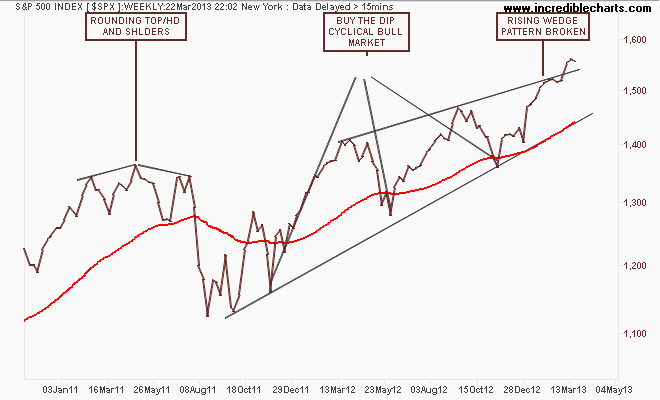
Looking at the short term technical point of view, this market remains bullish, with the 200 day moving average moving smoothly up left to right, breaking through resistance levels and bouncing off support in classic “buy the dip” fashion with a smooth trend channel since the November 2012 lows. The sideways move of the last 2 weeks is likely to see buying support at the bottom of the trend channel or below tentative support at 1540 points, with the continuation of the uptrend confirmed by a breakout above the recent high.
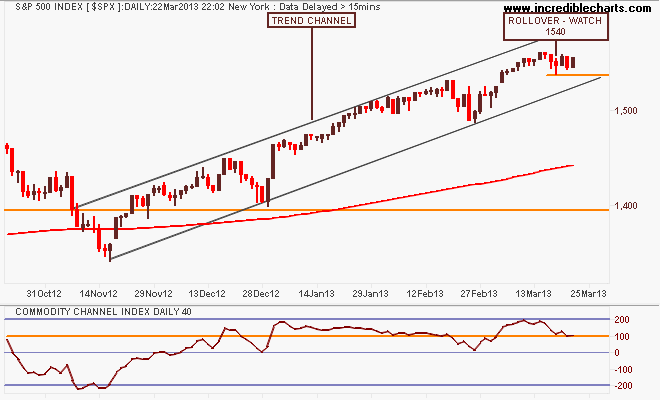
This is a high risk time for equity markets to say the least.
The local S&P/ASX200 index is halfway through its own secular bear market in my opinion, and mainly on the back of the banking sector. While it is now obviously in a cyclical bull market, there are several things to note in the monthly chart below.
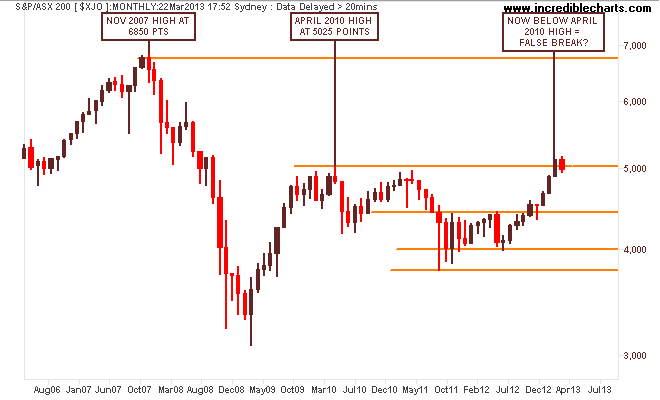
First, the key levels at 3800-4000 (strong support), 4400 (intermediate resistance and the outer edge of the index’s real value), 4900-5000 (strong resistance) and 6850 (the former high of the 2003-2007 bubble).
Before we go further, check how the above chart matches this chart from a Morgan Stanley study that shows how our current market is going right according to historical guidelines – and how many may confuse this as a false breakout in a secular bear market, not a new bull market.
We’ve had the rebound rally, a major correction (2011), and now we are in a trading range with cyclical rallies and corrections. My opinion is we are likely to have a similar triple top pattern to the end of 2009 (a series of small corrections and counter rallies) throughout 2013 as this cycle has been far too quick:
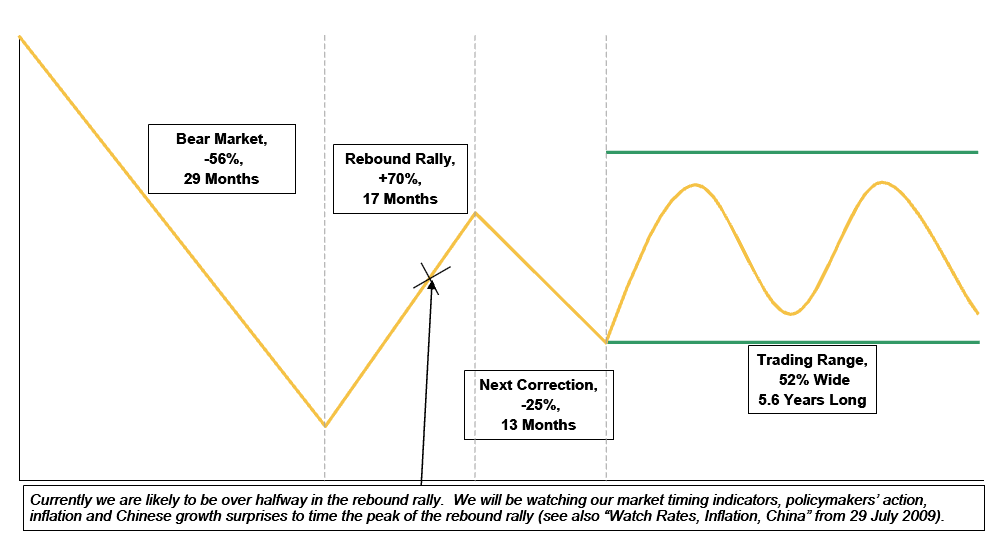
I have been warning of a correction for some time now and anyone looking at a weekly chart would come to the same conclusion. You do not have 13 plus straight weeks in a row continuing unabated without a correction of some nature:
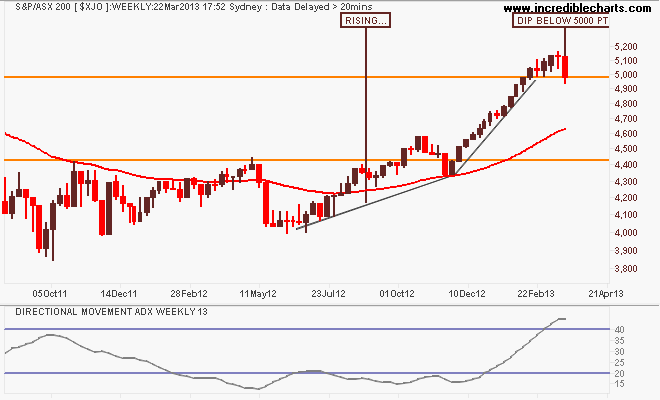
So far, this has only been a dip around 5% – I still feel a sizeable correction back to 4600 points would provide greater strength for a rally to properly break through 5000 points and further this year. Here is my technical target, based on a Fibonacci retracement of the GFC top and bottom. The 5000 point level is the 50% retracement, with the 61.8% giving an overhead target of 5400 points.
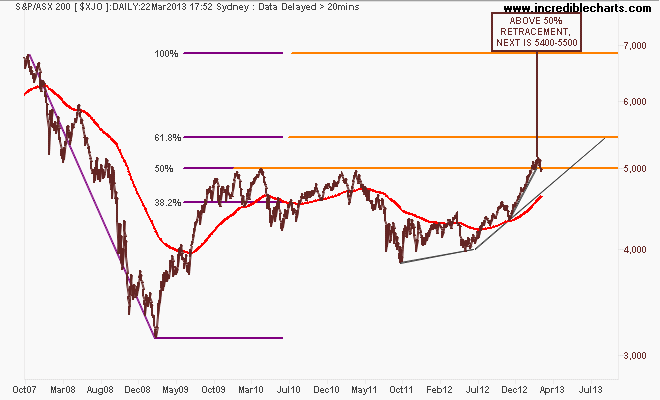
Here’s the short term view, where last week I pointed out how the MACDH indicator was showing a bearish divergence, which would only be confirmed on a break below 5000 points. We’ve had that break, but its been tepid in my view – “profit-taking” in the pundits lexicon – with a lot of intraday buying support:
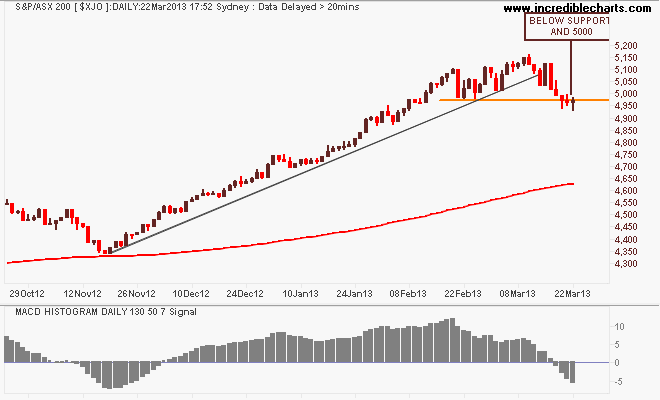
And a reminder this dip has been led by the miners – not the financials which remain extremely overbought and extended as yield chasing remains:
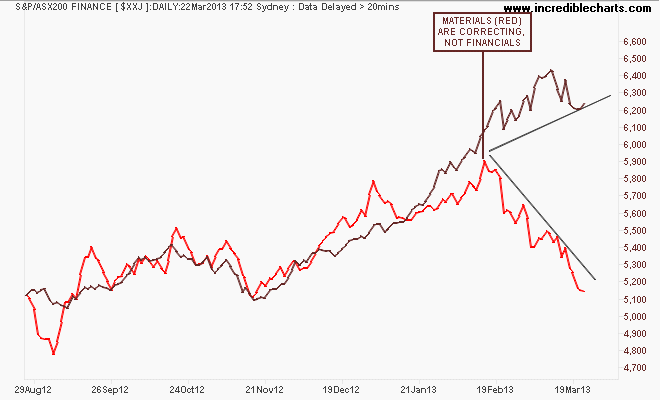
Its interesting how our local market has shrugged off the Cyprus deposit theft/bailout crisis, our own Italian style political opera and the rapid fall in iron ore and other material stock future earnings. Does this mean the local market consensus is robust or strong or just playing confidence tricks on itself?
Will we see another so-called rotation this time out of “expensive” banks and into “cheap” miners?
That’s all for now, remember to manage your risk first and the returns will come thereafter. See you next week and stay safe.
